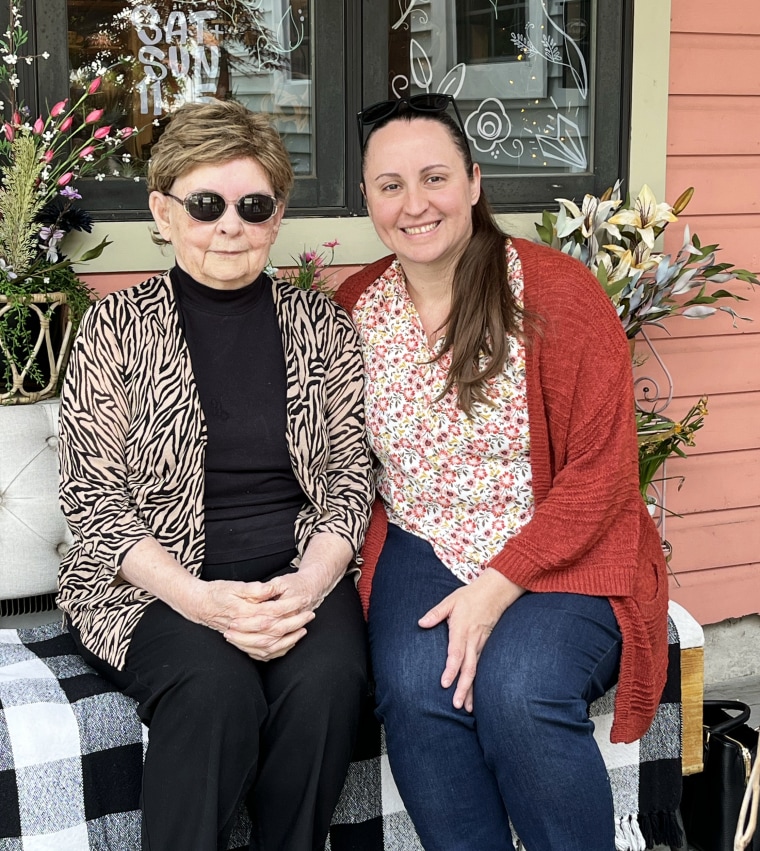As a teen, Brittany Aydelotte played sports. When she began experiencing groin pain in college, she thought it was just a sprain. But over the next month, the pain continued, and her calf became extremely swollen.

“It was feeling like it was almost going to pop, like there was just no possible way it could get bigger,” Aydelotte, 36, director of community engagement at the College of New Jersey, who lives in Cinnaminson, recalls to TODAY.com. “(It was) absolutely more swelling than keeping some water or day-to-day swelling. It definitely felt and looked much different than that.”Aydelotte soon learned what she was experiencing: Deep vein thrombosis (DVT), a type of blood clot that if left untreated can cause other health conditions or even be fatal.
It seemed like a sports injury but wasn’t
After spraining her ankle mulitple times over the years while playing sports, Aydelotte decided to visit a doctor in 2006 at age 18 because she had noticed some swelling in her calf. The thought it was a pulled groin muscle and suggested she use crutches. But the crutches did little to help. Then during a dance, the swelling and pain became too intense.
“I remember sitting down outside the dance and putting my leg up,” she says. “(I said), ‘We’ve got to go to the hospital. This is now no longer just something that hurts. There’s something really wrong.’”
At the time, Aydelotte didn’t know what was happening.
“I was playing club volleyball,” she says. “(I thought) it was very likely that I just stepped a little too wide.”
When she arrived at the emergency room, the doctor knew what was going on.
“They said, ‘Your heart rate is up. You have redness and swelling, all the indicators of what could be DVT,’” she says. “I had not heard of a DVT.”

Aydelotte later learned that she had two genetic blood disorders that contributed to her clot. On top of it, she had been taking birth control, which can increase the risk of clots for those predisposed to them. The emergency room doctor admitted her to the hospital, where she underwent treatment for the clot and a pulmonary embolism she developed when part of the clot in her thigh “broke off essentially and went to my lungs,” she explains.
She received IV blood thinners and frequent scans to monitor the clots. After, Aydelotte had to attend physical therapy to build up her strength from using the crutches.
“What had happened to my leg and muscles made me have to really work for a month or two to get back to comfortable walking,” she says.
DVT
DVT is a blood clot “that forms in the deep veins primarily in either the legs or the pelvis,” Dr. Adam Cuker, Aydelotte’s doctor, tells TODAY.com.
“The classic symptoms would be pain and swelling in one of the legs,” the DVT expert with the American Society of Hematology and director of Penn’s Comprehensive and Hemophilia Thrombosis Program says.
People at risk of developing deep vein thrombosis include those who:
- Had recent surgery
- Experienced a traumatic injury
- Have been hospitalized with limited movement
- Have a cast that prevents movement
- Are pregnant or postpartum
- Take hormonal contraception
- Have cancer
People who experienced DVT are more likely to experience it again.
“Probably the most important risk factor is a history of a prior DVT. If you’ve had one before, you’re definitely at increased risk,” Cuker says. “Fortunately, the treatments are very good at protecting against recurrence.”
Some people who experience DVT, such as someone who had a post-surgical blood clot, might only need short-term treatment. Others might need to be monitored for longer.
“There are other patients, like Brittany, where we worry about a very high risk of recurrence if we stop the blood thinner,” he says. “Those patients are often treated indefinitely.”

He notes that because Aydelotte has two different genetic risk factors for clots, she needs to be monitored and treated with anticoagulants. These patients are more likely to bleed easily so people have to “be cautious” when playing sports or being active.
Life after DVT
While Aydelotte needed physical therapy and sees Cuker regularly, life has continued normally. She stopped playing club sports, in part, because she got involved in another program at college. If she went out with her friends, she tried being cautious, though injuries can cause her to feel some extra stress.
“I stepped on a nail and to me that doesn’t just mean what it does to everybody else,” she says. “I have to actually go and get things check out a little differently.”
Aydelotte hasn’t experienced another DVT since the one she had n 2006. Sometimes she worries, though.
“It’s scary to have had something happen to your body that you didn’t have any control over,” she says. “Learning to trust your body again, learning to manage … it’s a little hard sometimes.”
She has post thrombotic syndrome, which means that she experiences symptoms that mimic those of a clot. This happens because after a DVT, a person’s leg veins might be damaged.
“The veins are not as good at bringing blood back up to the heart,” Cuker says. “Some of it pools in the leg, and ... this manifests for the patient (as) swelling in the leg, discomfort, pain, discoloration.”
This worsens if someone stands a long time or walks long distances, he adds. Aydelotte has to be mindful of that and takes breaks to rest her legs to avoid the uncomfortable symptoms. She also wears compression socks. Having supportive loved ones helps and a trusted doctor also helps Aydelotte manage.

Post a Comment